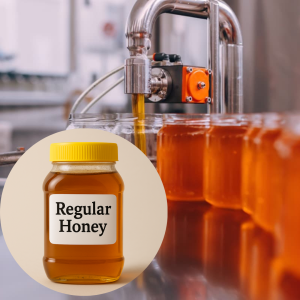What Makes Raw Honey So Different from Regular Honey?
Raw Honey is one of nature’s finest sweeteners—created by bees and packed with live enzymes, antioxidants, and nutrients. But here’s the truth: not all honey is the same. If you’ve ever wondered how raw honey differs from regular (processed) honey, this guide will clear it up for you.
What Is Raw Honey?

Raw honey is taken straight from the honeycomb and bottled, with Minimal filtration. Which means it still contains bee pollen, enzymes, and all the natural goodness. In earlier times, people enjoyed raw honey directly from the hive—it was thick, cloudy, and full of natural flavor.
What About Processed Honey?

As the demand for honey increased, so did profit-driven processing. That’s when Heavily processed honey entered the market. Producers heat it (called pasteurization) and ultra-filter it to make it smooth and shiny. While this may look appealing, it strips away much of its natural value.
Even worse, some regular honey may contain adulterants like high fructose corn syrup (HFCS) or rice syrup, which mimic honey but don’t offer any of its health benefits.
How to Tell the Difference
Here’s how raw honey stands apart:
-
Appearance: Raw honey looks cloudy and thick because it still contains pollen and enzymes.
-
Taste & Aroma: It varies based on the flowers bees forage on. So, each jar may taste slightly different.
-
Texture: It’s more natural and sometimes even grainy.
-
In contrast, regular honey is usually clear, uniform, and artificially smooth.
Why Is Raw Honey More Expensive?
It’s all about the timing and process. Large producers often extract honey before it fully ripens in the hive. Since unripe honey has more moisture, they need to heat it to stop fermentation. This processing helps with shelf life but kills off the good stuff.
Raw honey, however, comes from fully ripened honeycombs. Because it’s ready by nature, it doesn’t need heat or heavy filtration. Naturally, this careful sourcing takes more effort—hence the higher price.
How to identity weather the honey is Raw in the laboratory.
Raw honey can also be identified in a laboratory through its enzymatic activity—especially diastase, which is naturally present in high levels. Since raw honey isn’t exposed to high heat or harsh processing, it also shows lower HMF (Hydroxymethylfurfural) levels, a key indicator of freshness and minimal heat treatment.
Is Raw Honey Safe?
Yes, raw honey is safe for everyone except infants under one year. That’s because it may contain spores of Clostridium botulinum, which can cause illness in babies. For older children and adults, the immune system handles it without any issues.
Interestingly, in many cultures, elders give honey to newborns as a tradition—and rarely report problems. Still, doctors advise avoiding it for infants as a precaution.
How to Store Raw Honey
To keep raw honey fresh and safe:
-
Store it in glass, stainless steel, or clay containers.
-
Always keep the lid airtight to prevent fermentation.
-
Avoid exposing it to high humidity (above 48%), or it may absorb moisture and spoil.
What Are the Health Benefits?
Raw honey offers incredible benefits. It contains vitamins, minerals, enzymes, and antioxidants. These nutrients may help lower inflammation and support heart health. On the other hand, regular honey—after heating—loses most of these benefits.
Where Can You Get Raw Honey?
Your best bet is to buy from a local supplier or a trusted brand that directly sources from beekeepers. For example, Bharat Honey is one such brand offering raw honey collected from different regions of India.
How to Identify Raw Honey Today
Old-school tests no longer work. Modern adulterants can easily pass basic checks. Instead, look for these clues:
-
Variety of Honey – Real brands offer types like Jamun, Sidr, or Ajwain.
-
Transparency – Genuine producers clearly mention where and how they source honey.
-
Natural Variation – Raw honey changes in taste and texture. Fake honey stays uniform.
-
Advanced Lab Testing – Trust brands that back their purity claims with NMR or Carbon isotope tests. These can detect adulteration at the molecular level.
What About Organic Honey?
Organic honey sounds great, but the label can be misleading. Often, more organic honey is sold than what organic-certified land can produce. And if it’s processed, it loses most of its value—just like regular honey.
Raw honey, on the other hand, delivers what matters most: natural aroma, pollen, and enzymes that your body actually benefits from.
Conclusion:
Don’t be fooled by glossy labels. Learn how to recognize real honey, and choose raw when you can. It’s a small change that can make a big impact on your health—and help you avoid unnecessary medical bills.
Want real raw honey? Check out Bharat Honey.

